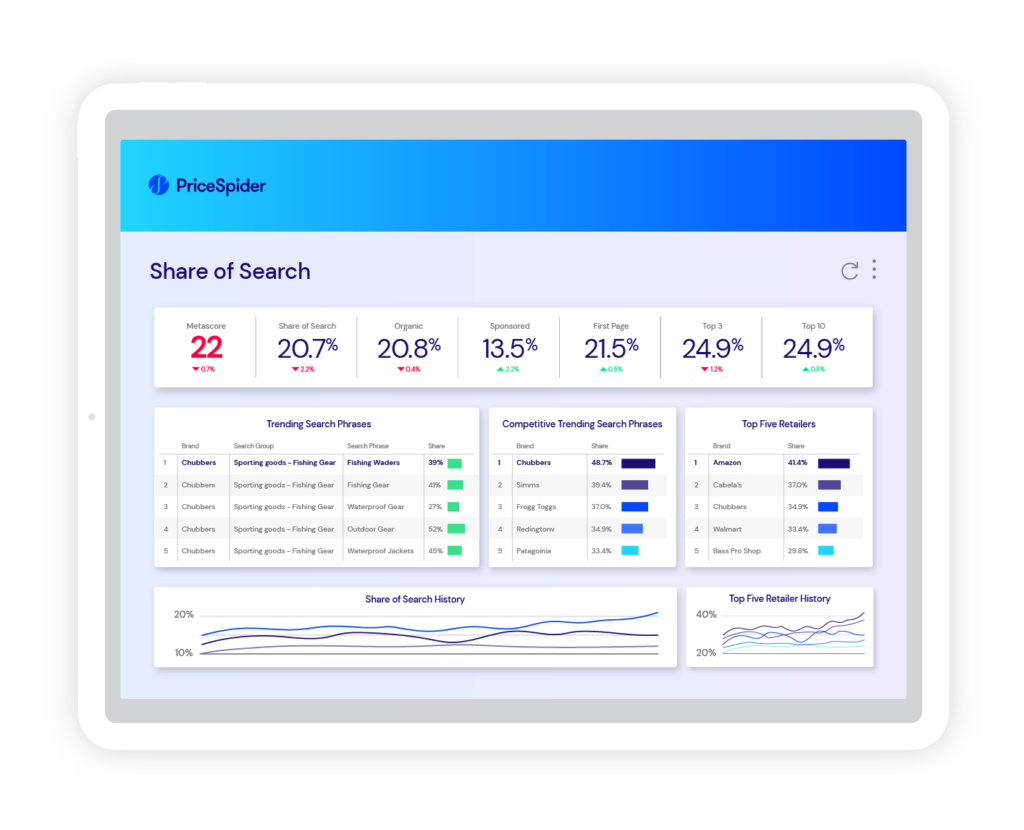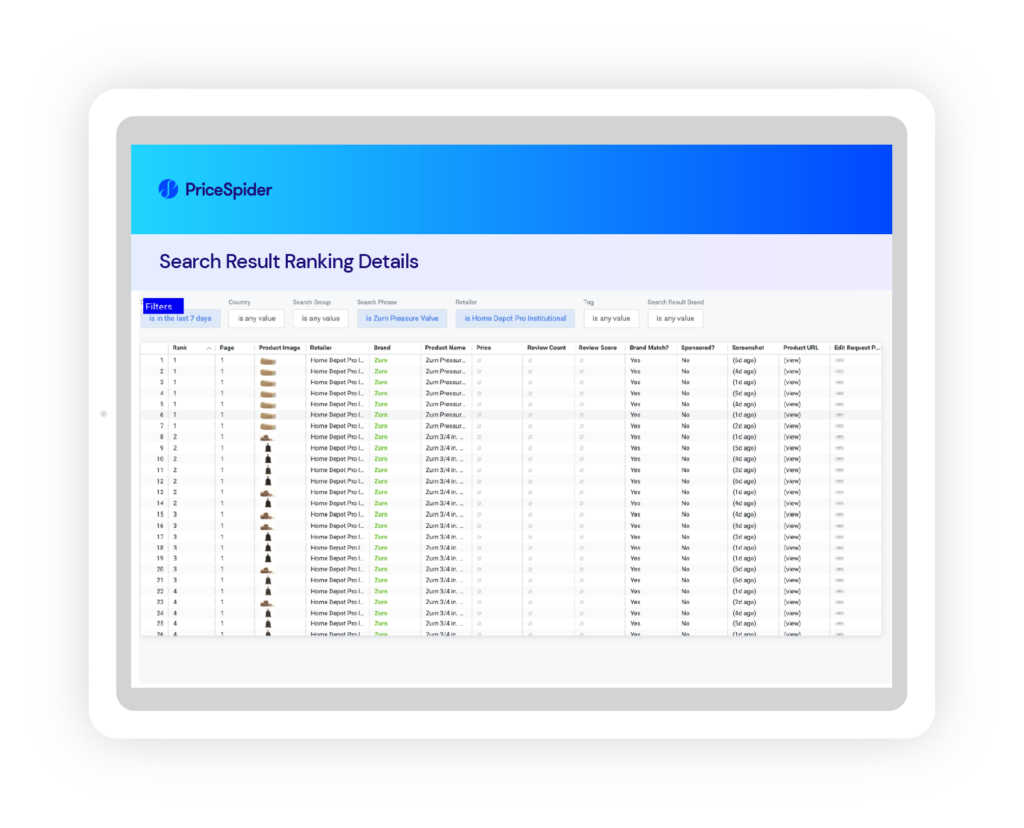As the brilliant creative character Don Draper said in the hit drama Mad Men, “You Are the Product. You Feel Something. That’s What Sells.” The fact that emotion and brand awareness are still very much the fabric of building a great brand isn’t lost in the era of modern marketing. This key principle is very much alive and well today, it just got a bit more technical than it was in the “golden era of advertising.” Share of Search is essentially the new “brand awareness” and a key metric to optimize your overall market share and sales performance.
Whatever you sell, you need customers to find your pages when they look for products like yours. Gaining ground in the right search results can immediately impact sales. Depending on the product category and the retailer, even moving up a single placement can result in thousands more views.
Most ecommerce brands put a lot of work into optimizing their product titles, descriptions, and assets to target the keywords and phrases consumers use. But then what? How do you stay on top of which products rank for which terms? How can you tell when something has changed?
With Brand Monitor’s Share of Search feature, you can monitor your position over time for every keyword that matters to each product, on every site you sell through. Whenever you review your performance in search, you’ll see helpful visual representations like this:

But what do you do with this information? As you explore how your Share of Search has increased, decreased, or remained the same, what can you do to improve performance?
Once you know where you’re at, here’s the process you should use to increase your Share of Search.
Identify how the results page has changed
For some search terms, the results remain fairly static. The brands and products that rank are well established, highly rated, and properly optimized. Other keywords are more volatile, with rankings constantly fluctuating and new players frequently entering the space.
If you want to improve your Share of Search, you need to look beyond your change in rankings and evaluate how the results have changed. Who bumped you out of the top three, or off the first page? Are the same competitors on top?
A single competitor may have made a significant jump. Or perhaps several have pushed into the top 10. When you can identify where the greatest movement has taken place, you can isolate the changes that likely resulted in that movement.
In other words, you’ll know which competitors to borrow strategies from.
Find what your competitors have done differently
The #1 search position typically goes to the most optimized (and/or popular) brand. But brands that significantly move up in rankings the most are also critical indicators of what a retailer’s algorithm focuses on. For some reason, the algorithm has determined that these brands are better results for the search term. Your job is to determine why.
Once you know which competitors you want to beat (or catch up to), you’re essentially playing a game of “spot the differences” with your product pages. What are they doing that you’re not? What do the top results have in common? What’s missing from your page?
Sometimes your product simply doesn’t have the ratings or branded search to earn a top spot in the results. But often, your competitors have just found better ways to satisfy the customers who use the specific term. Their product page has more signals that “this is what you’re looking for.” They’ve described the product in a way that assures people it will meet their needs.
Maybe they focused on different use cases. Different benefits. Or features. Perhaps they put the specifications up front instead of burying them in the product details. Or they used higher quality visual assets.
The applications you focus on, the benefits you highlight, and the assumptions you make about your target demographic can all help or hurt your rankings. If you want to hang with the top brands in your category, you need to follow the model that’s proven to resonate.
React to your customers
Sometimes your customers will tell you what needs to change in order for you to improve your Share of Search. Whether it’s through a popular question or a chorus of reviews with similar sentiments customers often highlight the benefits, features, specs, capabilities, and use cases that matter most to them. If these things are absent from your product description, that could be holding you back.
The more popular a question or sentiment is, the more likely it is that people are expecting to see that information more prominently. The brands that preemptively answer those questions and surface those benefits are going to satisfy more customers. (And they’re going to do it faster.)
Investigate what your customers are trying to tell you through reviews and questions, and update your page accordingly.
Adjust your ad spend
Any time you’re not getting the traction you want on a particular keyword, ramping up your ad spend can certainly help. It’s always possible that you’re not ranking because too few people have actually interacted with your page. The retailer may not have enough data to evaluate whether you’re a good result. Putting your brand in the mix through ads can also help increase your brand awareness, so next time people see you, you’ll be a familiar face in the product category.
While you can certainly double-up and advertise on keywords you already rank for, you may want to reallocate that budget toward the keywords you don’t have organic rankings for. This can give your pages more coverage, and ensures that you at least show up for the terms you’re after.
For every keyword you prioritize, Brand Monitor distinguishes whether your Share of Search is due to organic rankings or sponsored placements, so you can clearly see where you can afford to shift things around, and where you may want to apply more of your ad budget.

Monitor your Share of Search
You don’t need to check your rankings for every search term on every site every day. But you do need to know how your pages have ranked over the last month or previous quarter. Have you broken into the top three? Dropped out of the top ten? Or has the whole first page of results left you behind?
Brand Monitor gives you eyes and ears on the digital shelf—so you don’t have to watch and listen 24/7. In the Share of Search dashboard, you can explore how your rankings and your competitors’ rankings have changed over time,
Want to see what Brand Monitor can do for your brand?

